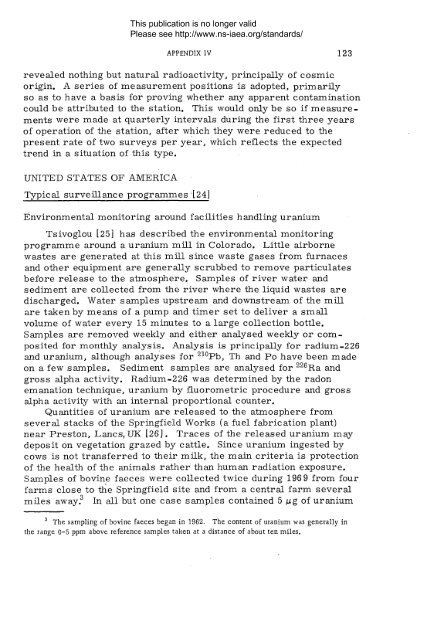Safety_Series_041_1975 - gnssn - International Atomic Energy ...
Safety_Series_041_1975 - gnssn - International Atomic Energy ...
Safety_Series_041_1975 - gnssn - International Atomic Energy ...
Create successful ePaper yourself
Turn your PDF publications into a flip-book with our unique Google optimized e-Paper software.
This publication is no longer valid<br />
Please see http://www.ns-iaea.org/standards/<br />
APPENDIX IV 123<br />
revealed nothing but natural radioactivity, principally of cosm ic<br />
origin. A series of measurement positions is adopted, prim arily<br />
so as to have a basis for proving whether any apparent contamination<br />
could be attributed to the station. This would only be so if m easurements<br />
were made at quarterly intervals during the first three years<br />
of operation of the station, after which they were reduced to the<br />
present rate of two surveys per year, which reflects the expected<br />
trend in a situation of this type.<br />
UNITED STATES OF AMERICA<br />
Typical surveillance program m es [24]<br />
Environm ental m onitoring around fa cilities handling uranium<br />
Tsivoglou [25] has described the environmental monitoring<br />
program me around a uranium m ill in Colorado. Little airborne<br />
wastes are generated at this m ill since waste gases from furnaces<br />
and other equipment are generally scrubbed to rem ove particulates<br />
before release to the atmosphere. Samples of river water and<br />
sediment are collected from the river where the liquid wastes are<br />
discharged. Water samples upstream and downstream of the mill<br />
are taken by means of a pump and tim er set to deliver a small<br />
volume of water every 15 minutes to a large collection bottle.<br />
Samples are rem oved weekly and either analysed weekly or com <br />
posited for monthly analysis. Analysis is principally for radium-226<br />
and uranium, although analyses for 210Pb, Th and Po have been made<br />
on a few samples. Sediment samples are analysed for 226Ra and<br />
gross alpha activity. Radium-226 was determined by the radon<br />
emanation technique, uranium by fluorom etric procedure and gross<br />
alpha activity with an internal proportional counter.<br />
Quantities of uranium are released to the atmosphere from<br />
several stacks of the Springfield Works (a fuel fabrication plant)<br />
near Preston, Lancs, UK [26]. Traces of the released uranium may<br />
deposit on vegetation grazed by cattle. Since uranium ingested by<br />
cows is not transferred to their milk, the main criteria is protection<br />
of the health of the animals rather than human radiation exposure.<br />
Samples of bovine faeces were collected twice during 196 9 from four<br />
farms close to the Springfield site and from a central farm several<br />
m iles away.3 In all but one case samples contained 5 /Ltg of uranium<br />
3 T h e sam p ling o f bovine fa eces began in 1962. T h e c o n ten t o f uranium was g en era lly in<br />
the range 0 - 5 ppm above re fere n ce sam ples tak en at a d istan ce o f about ten m ile s.

















